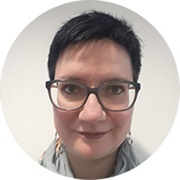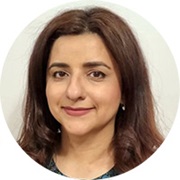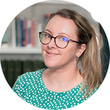- OT
- Life in practice
- Practitioner stories
- Reaching Deaf patients through British Sign Language
A conversation about...
Reaching Deaf patients through British Sign Language
Bobby Fida, optometrist and professional services manager at Asda Opticians, and Leeds LOC committee member and dispensing optician, Maryna Hura, explain how a CPD-accredited Deaf awareness and BSL course was facilitated.

07 August 2023
Could you tell OT about the project and your involvement in it?
Maryna Hura (MH): I started learning British Sign Language (BSL) in 2018. I did levels one and two, and then we were looking for continuing professional development (CPD) to deliver via Leeds LOC.

Maryna Hura
Occupation:Dispensing optician and Leeds LOC committee member

Bobby Fida
Occupation:Optometrist and professional services manager at Asda Opticians
Bobby Fida (BF): I’d completed BSL levels one, two and three in 2006 or 2007, and I felt that this would be a good refresher. The previous courses were more for communicating socially, as opposed to BSL use at work, as a primary care optometrist.
Even though we don’t use it every single day, it’s a language that makes sense. It has its own little quirks, but it is a common sense language and a language that we all should have some grasp of.
I thought, if we were going to be taught by somebody who had spent time looking at how optometrists and dispensing opticians can use their language and tailor it for patients, it would be worth it. It was on Zoom on four consecutive Mondays, and I signed up to refresh my knowledge and learn a bit more about how to engage with Deaf people. The number of places was small because it was interactive, and we all needed to be visible on the screen and able to sign back live.
It has its own little quirks, but it is a common sense language and a language that we all should have some grasp of
When did you become aware that there was a need, in practice, to engage the deaf community in this way?
MH: I’ve been in optics for 20 years. I’m a dispensing optician and I have come across a number of deaf BSL users in practice, and we haven’t always had interpreters for them. On one occasion we even had to seek help from a member of staff with BSL level two from the neighbouring pharmacy.
I think it is a good idea to learn sign language, as without it you feel almost helpless when dealing with Deaf patients.
The number of BSL users nationwide is growing. The British Deaf Association conducted a census in 2021 and noted that, since 2011, there had been a 50% increase in BSL users.
I think there would have always been a need for it, but BSL wasn’t recognised as a language up until 2022. The Deaf community is still very much in minority.
Before the BSL course, I had done a little bit of research on the experience of Deaf patients in practice. Unfortunately, a lot of responses were not particularly positive. We, as optical professionals, could make some changes for better; perhaps something should have been done a long time ago with regards to increasing Deaf awareness in practice.
I teach at Bradford College, and I have incorporated a lesson in one of my modules on Deaf awareness, with some basic signing. So far, students have enjoyed these sessions, some have even been inspired to carry on learning the language. Perhaps there is even room for BSL being an optional subject on optometry and ophthalmic dispensing courses within the relevant schools.
We just need a group of people who are interested, who are passionate, and who are willing to drive this. Raising awareness of Deafness needs to be a joined effort. At this stage, we are just planting the seeds in everyone's minds and saying, ‘we need to move forward with this.’
BF: My daughter is Deaf. When she was diagnosed, she was 14 months old, and her first language was BSL. As a family, we were learning to sign. Even before we knew she was deaf, I had started taking her to 'sing and sign' classes to help with communication. When she was nine months old, she could communicate nine or 10 signs. For instance, she could tell me when she was hungry, when she wanted milk, and even when she needed a nappy change. For a baby of nine months, that was pretty remarkable.
It’s based on research I’d come across, suggesting signing is easier for a baby to communicate with than speech. Language is a complex skill, that develops much later. Although we just happened to be using some signs as a family, we started signing fully when we found out she was Deaf.
Going to all the different appointments, hospital checks, from 14 months old to joining school, was very challenging. I started networking with the Deaf communities in Leeds and Wakefield. There were more Deaf children and support groups in Leeds, and we used to do a lot of activities with them.
At work, it is about awareness of what we can do to make things more accessible, just like you would for any other patient. I make it quite clear to staff and patients who are booked in that I’m not their interpreter. I am their optometrist, and if they want or need an interpreter, we can arrange that. But hopefully the skills you pick up on a course like the one Leeds LOC ran help provide useful tips, and support patients in feeling less stressed and anxious.
The optometry environment is the worst environment for Deaf people: dim lights; face masks. Some practices can have background noise. A lot of the time when we're communicating, we’re beside them, not in front of them. We might be talking whilst looking at a screen, or looking down when making notes. None of this helps Deaf patients. The more often you look after patients with hearing problems, the more you realise that we need to change to make eye care more accessible to patients.
It’s similar to when you travel to a different country and don’t wish to offend. We all try to include the language and learn common phrases, as you want to help. It’s the same when dealing with the Deaf community. There a huge number of people around us who are Deaf, and the numbers are rising. There is a link with eye care: as people live longer, they are more likely to be affected by cognitive decline, which includes sight and hearing impairments. So, we do need to adapt our language and style of communication. We are being encouraged to look at people holistically. We can’t isolate eye health, but should consider the whole picture.
The more you look after patients with hearing problems, you realise that we as care providers need to change to make eye care more accessible
How was the process of getting optometrists to join the lessons? How did you make them understand that this was important?
MH: I don’t think a course like this had run before as a CPD event. We had 15 participants, including committee members. Four days is a big ask, and we made it quite clear that the practitioners had to join all four sessions. If we were to do it again, we might rethink the logistics of it. It was a lengthy process between me and the trainer from Action Deafness, to organise everything. Despite the attendance requirement, there was an expression of genuine interest, which meant getting optometrists and dispensing opticians to join the course was easy.
BF: There was a resource booklet that accompanied the class, and there were tips at the end of each session to practise certain aspects before the next session. The session provided a few tips and signs, which we were encouraged to incorporate into our normal practice that week, and then build upon over the coming sessions. I think it was good that it was over four weeks, rather than trying to take all that information in during a single session. Four weeks consecutively allows you to embed that information and build upon it in layers, rather than taking it in all at once.
Everyone seemed to engage well and enjoy it. People had their videos on and we all signed every time an instruction was given.
At Asda Opticians, we also ran a Deaf awareness session during our annual CPD event in response to request and identifying the need for this. There have been Deaf contestants on Love Island and Strictly Come Dancing, helping raise a little more awareness, which has been helpful and has allowed Deaf people to have a voice.
MH: It was a really well organised event. The interpreter and the trainer worked really well together. The handbooks were tailored to us – I sent a list of vocabulary I wanted to be included in the training pack, and I think some of the signs evolved because of it. The first two sessions were generic, and then it was tailored to optometrists and dispensing opticians.
How has doing this improved your communication with the Deaf community in practice?
MH: I terms of Deaf awareness, I hope it will continue to improve within our profession. LOCs from other regions have since expressed interest in delivering similar courses. I can only imagine it’ll have a positive effect. Members of staff are learning to fingerspell their names, and using very simple signs to make their deaf patients more welcome. On social media, I’ve seen some evidence of people having a go.
BF: I think there is a responsibility on the optical sector. I’ve heard comments: ‘we don’t get a lot of Deaf people coming into our practice,’ or ‘I’d love to learn but I don’t feel that there are enough people.’
We know the stats: we know there are people who are Deaf; we know there are people who are hard of hearing. If you’re not getting those people in your practice, there’s a misfit. It’s about that allyship that we talk about in all areas of equity, diversity and inclusion. There are people who won’t come for eye care due to barriers and are potentially at risk of losing sight. There is work to be done, as a sector, for us to reach out to communities where there are hearing issues.
We do it well with the older population. Dispensing opticians are great, looking after people who wear hearing aids, fitting their glasses with them, reassuring them to wear their hearing aids when they come to have their eye test. People who are hard of hearing often deliberately leave their hearing aids at home, because they think the hearing aid is going to be a nuisance during the eye test. It’s that kind of awareness and education: we do need to try and get those people in, and look after them. The onus is on us to do that.
There are little things we can do that have a significant effect on people and hopefully, as you make changes, others will follow on that journey too.
MH: There are 450,000 people in the UK who are Deafblind, but by 2035 that figure is set to rise to 610,000. Unless we improve access for our Deaf patients, some people may not want to return to practice because of a bad experience and, as a result, potentially miss out on essential eye care.
Often hearing people forget that written communication is not always the best, especially if we use complex terminology, or long leaflets. A Deaf person may not read it, especially if English is not their first language, and give up. As part of the hearing community, there are so many things we don’t know about the Deaf culture, about their humour, about their way of life. As my BSL teacher once said: ‘Deaf people don’t need help, they need access.’
BF: They’re an independent, thriving community, with some great role models. But it should be fair access. We are professionals, we should be offering a service that is equally accessible for all our patients, and that includes the Deaf community.
As part of the hearing community, there are so many things we don’t know about the Deaf culture, about their humour, about their way of life. They don’t need our help. They need access
What would you say to people who want to facilitate this kind of training within their practices or within their LOCs?
MH: I would encourage them to go ahead and organise similar training; get in touch with a local Deaf centre or a relevant charity, who would be happy to help. It’s something you can’t put a price on. Get in touch with a Deaf centre or Deaf club, or charities. COVID-19 taught us that a lot of things can be done online easily, so it doesn’t have to be face-to-face.
BF: Councils used to be able to offer signing classes as part of their budget, and that’s no longer the case in some. People with Deaf children are expected to pay for sign language courses. That is a problem. There are some Deaf clubs and charities that offer support, but they too have tight budgets. LOCs have funds that may be used to raise awareness. If you can be an ambassador in your LOC for people with additional needs, then this is right up there as a worthwhile initiative.
A good tip is to try and do it regionally. If your LOC area is quite small, join up with neighbouring LOCs. Three or four LOCs can come together and deliver a session. In person would be great, but if it’s regional, the virtual one worked really well.
The Deaf community is brilliant at technology. They use it for so many different aspects of their lives. They are brilliant and efficient at using it. So, don’t be put off if you can only deliver it virtually.
Look at NHS resources as well. As primary care practices, we are part of the NHS network, because we deliver an NHS contract. At your Integrated Care Board level, there may be courses or resources that you can tap into. LOC members would welcome learning a new practical skill, which can also be useful for communicating with the very young.
Being aware of what clothes to wear when you’re signing, so that your hands don’t blend with your top. How to make sure your hair is not covering your face. Making sure you’re not talking behind the slit lamp, so someone can’t read your lips. It’s all those little things that can be useful, even without the signing aspect, to help you learn how to deal with people who are hard of hearing.
We’re seeing more and more people in practice who are losing their hearing and gradually need a bit more support. They get embarrassed and uncomfortable if they ask you twice, three times, or four times, to repeat what you’re saying. It must be heart-breaking to not be able to hear.
We’ve all experienced a little bit of that in recent times. How many of us said, when talking to someone wearing a mask, that we couldn’t understand what they were saying without the movement of their lips? That muffled sound behind a mask – we’ve all struggled. Obviously, for a hard of hearing person or a Deaf person, it’s so much worse than that. We’ve all had a little bit of a flavour of what it’s like, and I think we should channel that to try and do a little bit more.
With the new CPD scheme, there’s a welcome opportunity adapt and broaden your learning. This is non-clinical, and a little bit different. Even if you find a course that’s not provided by someone with an optical background, you can self-direct it.


Comments (0)
You must be logged in to join the discussion. Log in